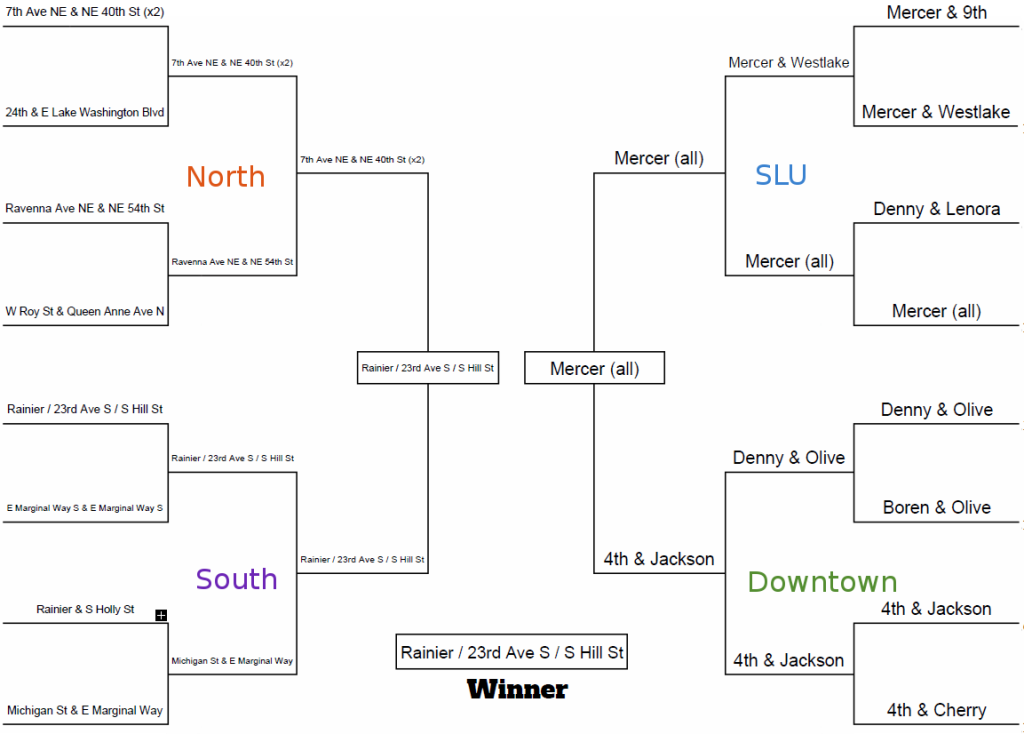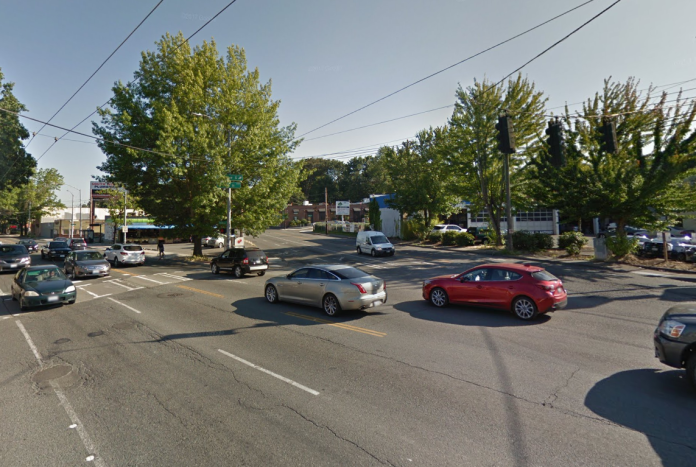For the first time ever, Seattle’s worst intersection is in South Seattle. Rainier, 23rd, and Hill beat out numerous other contenders to be chosen by readers of the Urbanist as the worst intersection in Seattle for people walking, biking, and busing.

The Worst Intersection in Seattle contest was conceived in 2010 to call attention to issues in our built environment that affect pedestrians. Starting this year, the scope has expanded to consider the perspectives of bicyclists and bus commuters as well.
Similar to last year’s winner, Denny and Stewart, Rainier and 23rd is a traffic-clogged intersection that should primarily serve traffic on its way to the nearest freeway, according to SDOT. However, both intersections fail in that regard due to regular backups from the freeway that slow down frequent bus routes and block crosswalks.
Rainier and 23rd may be even worse for pedestrians than Denny and Stewart, with narrower and more uneven sidewalks that are placed closer to streets that carry faster-moving traffic. 35,000 cars per day travel along Rainier, Seattle’s most dangerous street, and over 10,000 on 23rd. There have been over a dozen collisions in the last five years at this spot.
The intersection of Rainier and 23rd was constructed over 100 years ago and is essentially the same today, except with traffic lights and limited pedestrian crossings. In fact, because people can’t walk across Rainier along the north side of the intersection, certain routes require walking across five crosswalks. The streets are wide and cross at an angle so that it takes a long walk to get to the other side. For example, the walk across 23rd along the east side of Rainier is 116′, which is equivalent to crossing an 11 lane road.
A lack of investment is certainly apparent when you compare this intersection with the runner-up, which was actually several intersections: all of Mercer Street’s intersections in South Lake Union. Mercer St was recently re-built with hundreds of millions of dollars of federal and state money, its lights were re-programmed with tens of millions of city money, and it’s surrounded by buildings that have sprung up as the result of millions if not billions of dollars from private and corporate investors. Of course, these things weren’t done well, which is why Mercer St made it all the way to the finals.
By contrast, Rainier and 23rd is surrounded by low-density, auto-oriented stores that haven’t changed in years. There are a couple car repair shops, a fast food restaurant, a convenience store, and a seemingly-abandoned building. A little private investment and new buildings could make a huge difference in the streetscape, allowing the sidewalks to be widened, providing more landscaping, and generally creating a more comfortable experience for people walking through.
Fortunately, SDOT has already started work that will transform the intersection as part of the 23rd Ave Corridor Improvements Project.
23rd Ave is getting sidewalk improvements as well as landscaping and street tree installations, as covered previously on The Urbanist. Most significantly, however, this intersection will change from a six-way intersection to a four-way intersection with crosswalks across all streets.
A year from now when construction is complete, Rainier and 23rd will be much better to walk across. But this year it’s the worst intersection in Seattle.
Troy is a pedestrian advocate who serves on the board of Seattle Neighborhood Greenways. He loves cities and walking, hiking, and biking. He wrote a book to help others looking to find the right place for them, called Move to the Place of Your Dreams: A Relocation Handbook. By day, he is a professional consultant for a technology firm.


